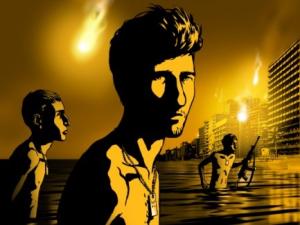Waltz With Bashir
 Profoundly humane and stunningly aesthetical, Waltz with Bashir is not about dancing…not even around the bullets of one’s enemies as does an Israeli soldier in the eponymous scene. Through the personal lens of his experience as a soldier during the Sabra and Chatila massacres of the 1982 Lebanese war, Israeli director Ari Folman tells the universal story of young men and the harrowing consequences of war upon them. With his conscious use of drawings instead of live-action or even rotoscope animation, Ari Folman may have paved the way for a new genre: the animated documentary.
Profoundly humane and stunningly aesthetical, Waltz with Bashir is not about dancing…not even around the bullets of one’s enemies as does an Israeli soldier in the eponymous scene. Through the personal lens of his experience as a soldier during the Sabra and Chatila massacres of the 1982 Lebanese war, Israeli director Ari Folman tells the universal story of young men and the harrowing consequences of war upon them. With his conscious use of drawings instead of live-action or even rotoscope animation, Ari Folman may have paved the way for a new genre: the animated documentary.
 The process is semi-psychoanalytical: by interviewing his reluctant
fellow soldiers about their recollections of the Sabra and Chatila
massacres of the 1982 Lebanese war (when Israeli forces allowed
Christian Phalangist militia into Palestinian refugee camps to
slaughter civilians), the director’s memories rush back in the form of
reveries and nightmares. The dreamlike quality of the film permeates
the pictures and sounds alike, with the eerily original score by
composer Max Richter (after a serendipitous call from Ari Folman) and
the ironic use of pop songs (“I bombed Sidon today” or “This is not a
love song”).
The process is semi-psychoanalytical: by interviewing his reluctant
fellow soldiers about their recollections of the Sabra and Chatila
massacres of the 1982 Lebanese war (when Israeli forces allowed
Christian Phalangist militia into Palestinian refugee camps to
slaughter civilians), the director’s memories rush back in the form of
reveries and nightmares. The dreamlike quality of the film permeates
the pictures and sounds alike, with the eerily original score by
composer Max Richter (after a serendipitous call from Ari Folman) and
the ironic use of pop songs (“I bombed Sidon today” or “This is not a
love song”).
This journey into forgetfulness and memories regained, in which we are taken, is both devastating and illuminating.
Who could have thought than an animated film would offer a realistic
glimpse of what it is to be a young soldier. Waltz with Bachir utterly
departs from the clichés of live-action Hollywood films which, beyond
their self-claimed anti-war message, always seem to end up
romanticizing heroism and male bonding.
Here, the young Ari Folman and his fellow soldiers are infused with
fear, stupor and loneliness, the only exceptions to this bleak
portrayal of reluctant warriors being a fellow soldier-turned-karate
master, who fired his gun in the air at his unseen enemies, while
dancing around their bullets, under the giant portrait of Bachir, their
charismatic Christian Lebanese leader.
 Gorgeously drawn and evocative scenes come aplenty. The enormous guilt
and horror bearing upon the mature soldiers is effectively translated
in the opening sequence where his fellow soldier tells him of his
recurrent nightmare of being chased by 26 vicious dogs. The mystery of
war is highlighted with an openly-textured scene, which beautifully
punctuates the director’s journey down memory lane, like a recurrent
dream, with boyish-looking naked soldiers, emerging in slow motion from
the sea with their gun, bathed under the red-ochre moonlight.
Gorgeously drawn and evocative scenes come aplenty. The enormous guilt
and horror bearing upon the mature soldiers is effectively translated
in the opening sequence where his fellow soldier tells him of his
recurrent nightmare of being chased by 26 vicious dogs. The mystery of
war is highlighted with an openly-textured scene, which beautifully
punctuates the director’s journey down memory lane, like a recurrent
dream, with boyish-looking naked soldiers, emerging in slow motion from
the sea with their gun, bathed under the red-ochre moonlight.
The search for manhood and motherly protection is sensibly evoked in another memorable scene portraying one of his fellow soldiers being scared sick on a transportation ship and dreaming of being saved by a giant voluptuous woman. The divorce between the military and the rest of society is sharply emphasized in yet another uniquely-observed scene showing the young Ari Folman on leave, wandering alone in the Tel Aviv streets and nightclubs, bristling with sexuality and indifference.
Was he physically there? Is being an unconscious witness a crime? These devastating moral questions run through this anti-war testament, entwining the director’s story and Israel’s history. Despite the harrowing ending sequence showing Palestinian women in mourning (the only occurrence of archival footage in the film), Waltz with Bachir was not met with controversy in Israel and was even well-received to a certain extent. That is why Ari Folman’s travels into war memories will not be easily forgotten, at the very least in cinema history.